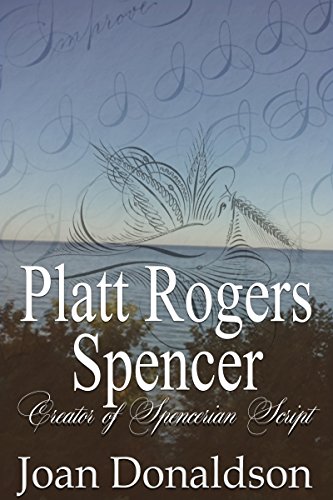Joan Donaldson
Platt Rogers Spencer: Creator of Spencerian Script
language
( Nov. 15, 2017)
While some may think that handwriting is archaic skill in a keyboard world, researchers have learned that teaching children penmanship benefits brain development and enhances their ability to think.
“When we write, a unique neural circuit is automatically activated,” said Stanislas Dehaene, a psychologist at the Collège de France in Paris. “There is a core recognition of the gesture in the written word, a sort of recognition by mental simulation in your brain.” https://www.nytimes.com/2014/06/03/science/whats-lost-as-handwriting-fades.html
What most Americans do not know is that the handwriting they learned was created by a ten-year boy who lived at the edge of the Northwest Territory.
In 1810, Platt Rogers Spencer eyed the angle of the rolling waves of Lake Erie and the oval pebbles scattered across the strand. With a quill, Spencer transferred these common shapes found in nature into a new style of penmanship. Instead of only moving his wrist as Spencer wrote, he employed his shoulder muscles to move the quill. The young penman created a uniquely American form of handwriting that would reflect the vibrant spirit of his nascent country, and for the rest of his life, Spencer promoted the script that bore his name. The Father of American Penmanship published the first copy books that featured his script so that school teachers didn’t need to prepare small paper slips with examples of letters for their students to replicate. Spencer’s books were the most commonly used in American schools. Believing in practical education, he founded the first business college in Pittsburgh, PA and also enrolled women in his Log Cabin Seminary so that they could train to become clerks.
When not teaching Spencer also wrote and published poetry. A reformed alcoholic, he lectured on behave of the Temperance Movement and promoted the end of slavery. His artistic mind also envisioned how to utilize the shapes from his letters to create “off-hand flourishing”, a pen and ink folk art that creates graceful birds, cartouches and sometimes leaping stags. After his death, Spencer’s children continued to teach his script, publish new editions of his curriculum, and kept his legacy alive.
“We never give much thought to handwriting these days, especially as the ubiquitous keyboard has lessened the call for it and fewer children are taught penmanship. But in nineteenth century America, Platt Rogers Spencer developed a curriculum for legible handwriting that schools adopted. The Spencerian style, as it came to be known, provided an essential uniformity in communication. The story of the man, his method, and widespread influence he had in helping Americans make their written thoughts understood is neatly told in Platt Rogers Spencer. In the era before typewriters and computers, handwriting mattered and Joan Donaldson’s Kindle Single will provide deserved attention to Spencer’s achievement.”
—James McGrath Morris, author of Pulitzer: A Life in Politics, Print, and Power.
“When we write, a unique neural circuit is automatically activated,” said Stanislas Dehaene, a psychologist at the Collège de France in Paris. “There is a core recognition of the gesture in the written word, a sort of recognition by mental simulation in your brain.” https://www.nytimes.com/2014/06/03/science/whats-lost-as-handwriting-fades.html
What most Americans do not know is that the handwriting they learned was created by a ten-year boy who lived at the edge of the Northwest Territory.
In 1810, Platt Rogers Spencer eyed the angle of the rolling waves of Lake Erie and the oval pebbles scattered across the strand. With a quill, Spencer transferred these common shapes found in nature into a new style of penmanship. Instead of only moving his wrist as Spencer wrote, he employed his shoulder muscles to move the quill. The young penman created a uniquely American form of handwriting that would reflect the vibrant spirit of his nascent country, and for the rest of his life, Spencer promoted the script that bore his name. The Father of American Penmanship published the first copy books that featured his script so that school teachers didn’t need to prepare small paper slips with examples of letters for their students to replicate. Spencer’s books were the most commonly used in American schools. Believing in practical education, he founded the first business college in Pittsburgh, PA and also enrolled women in his Log Cabin Seminary so that they could train to become clerks.
When not teaching Spencer also wrote and published poetry. A reformed alcoholic, he lectured on behave of the Temperance Movement and promoted the end of slavery. His artistic mind also envisioned how to utilize the shapes from his letters to create “off-hand flourishing”, a pen and ink folk art that creates graceful birds, cartouches and sometimes leaping stags. After his death, Spencer’s children continued to teach his script, publish new editions of his curriculum, and kept his legacy alive.
“We never give much thought to handwriting these days, especially as the ubiquitous keyboard has lessened the call for it and fewer children are taught penmanship. But in nineteenth century America, Platt Rogers Spencer developed a curriculum for legible handwriting that schools adopted. The Spencerian style, as it came to be known, provided an essential uniformity in communication. The story of the man, his method, and widespread influence he had in helping Americans make their written thoughts understood is neatly told in Platt Rogers Spencer. In the era before typewriters and computers, handwriting mattered and Joan Donaldson’s Kindle Single will provide deserved attention to Spencer’s achievement.”
—James McGrath Morris, author of Pulitzer: A Life in Politics, Print, and Power.
Enjoy reading Platt Rogers Spencer: Creator of Spencerian Script? You may also like these books




